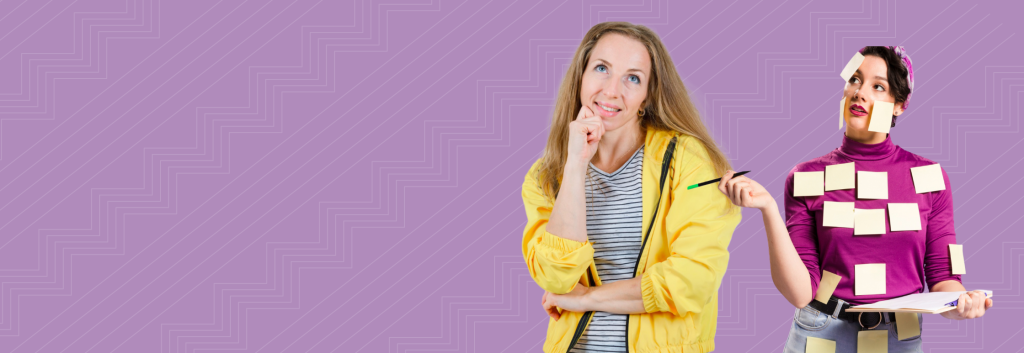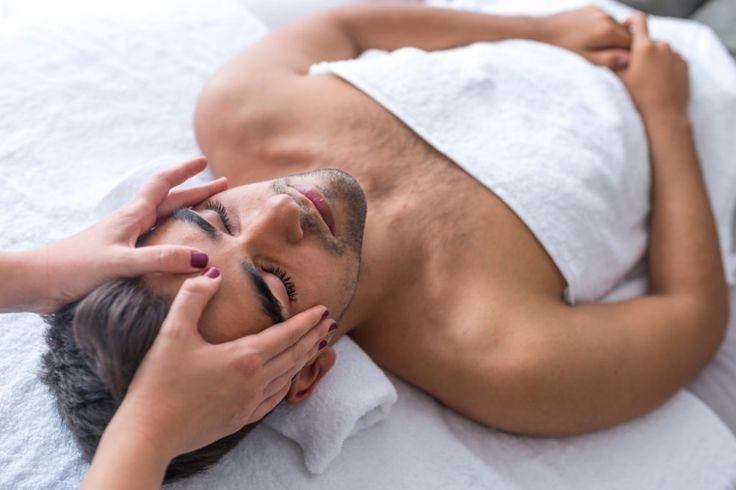Skin massage has traditionally been used to prevent the development of pressure ulcers, on the assumption that massage increases local blood flow to tissue which have been subject to pressure. Skin massage is a treatment you can do with a practitioner or on your own. The technique involves stimulating pressure points on the face, neck, and shoulders. You can use lotions, oils, or cleansing balms with facial massages, as well as a face roller or a flat gua sha tool.
Massage is a stress reliever; if you have a skin condition like rosacea that flares up due to stress, it can help keep you relaxed and free of flare-ups.
However, massage is not always good for the skin, so you need to be careful. If you do have rosacea, you want to avoid facial massages, because the increased blood flow to your face can aggravate the condition and cause a flare-up. You also want to avoid heat-intensive massages, because the heat can also trigger rosacea.
Before you get a massage, you should also consider the current state of your skin. If you have a specific skin condition that can cause skin infections or wounds, you’ll want to skip the massages until your skin heals.
Benefits of massage for the skin
1. Improves circulation
Massage facilitates circulation because the pressure created in the massage technique moves blood through congested areas. The release of this same pressure allows new blood to flow in. Your skin will not only feel better as a result of improved circulation, but it will also look better. Increased blood flow in your skin will give you an overall glow and will improve the look and feel of your skin.
2. Exfoliates the skin
Regular massages will also help reduce the buildup of dead skin cells on the skin’s surface. Removing dead cells from your skin will improve the overall health and appearance of your skin. Exfoliation improves overall health and wellness by improving circulation and relaxing your body during the process. The appearance of your skin will improve because exfoliation tightens pores, improves skin’s texture, and gives your skin an overall brightness.
3. Moisturizes your skin
With the right massage oil and technique, a massage will also leave your skin feeling nourished, hydrated and smooth. Moisturizing your skin by way of massage allows your skin to absorb the nutrients in the oil or cream far more easily.
4. Reverses the negative effects of aging
Wrinkles develop because the face tends to contract muscles in the same direction. Facial massages help reduce the appearance and development of wrinkles by relaxing the facial muscles.
5. Relieves symptoms of TMJ
People who have temporomandibular joint (TMJ) conditions may experience discomfort in the jaw or face. This can include headache, earache, or lockjaw.
According to the Cleveland Clinic, trigger point massage may help alleviate tight, inflamed, or painful jaw muscles. This discomfort may be due to chewing, jaw clenching, or teeth grinding.
Massage to relieve symptoms of TMJ may be especially effective when combined with jaw exercises.
6. Causes facial rejuvenation
Facial massages can help relieve tension while enhancing relaxation and skin health.
Research from 2018 points to the effectiveness of facial massage with a Pao device in encouraging facial rejuvenation. The facial massage exercise device was shown to boost facial muscle thickness and cross-sectional area in women who used the device for 30 seconds, twice a day for 8 weeks.
7. Manages scar tissue
If you have a facial scar that’s in the healing process, massage can be greatly beneficial. Massaging the scar tissue and surrounding areas may help increase blood flow, loosen up nearby tissues, and flatten bumps.
Facial massage may also help relieve symptoms such as pain, itchiness, and tenderness.
8. Activates the lymphatic system
The lymphatic system functions as the body’s garbage disposal: It helps remove waste and toxins from bodily tissues, including the skin. When it becomes sluggish, toxins build up and block our lymph nodes, causing the skin to look puffy.
Lymphatic drainage is a gentle massage technique that encourages the movement of lymph fluids throughout the body. This type of massage targets the lymph nodes under the ears and on the neck, helping to drain toxins and remove excess waste. This, in turn, minimizes swelling and helps to “de-puff” the skin.
How to do facial massage at home
Whether you have 5 minutes or an entire hour, you can put together your favorite elements to create an individualized facial massage routine. Repeat each stroke five times or focus on a specific area for 20 to 30 seconds.

1. Cleanse hands & face
Always start with a clean base. Prep your skin by cleansing and removing all makeup. And, ensure your hands are clean so you don’t transfer bacteria to your just-cleansed complexion.
2. Warm product in hands
The key to a successful facial massage is slip. A small amount of serum, oil, or concentrate helps your fingers move more smoothly across your face – and ensures the actives reach the deepest layers of your skin. Simply apply a small amount of product into your palms and rub the formula to evenly distribute it over your hands and fingertips.
3. Use gentle but firm pressure
You want to apply enough pressure that you can truly feel and move the muscles beneath the skin. Don’t go too hard on your skin. A facial massage is not a deep tissue massage: Use firm pressure, but keep it gentle.
Work with muscle when it comes to massage, not just the surface of the skin, and use pressure with purpose.
4. Start by massaging the lymph area
Begin by activating your lymphatic system. Using the tips of your fingers, massage the lymph nodes under your ears and along the sides of your neck. Use wide circles, sweeping from under your ears, down toward your throat, and back up along your jawline. This will encourage the build-up that is causing you to feel puffy or swollen to keep moving.
5. Knead the sides of your face
Next, target the sides of your face. Use circular motions to massage the perimeter of your face, along the sides of your jaw, and up over your cheekbones. Remember to push your skin up and out – not down. This will help to lift sagging skin and prevent the skin from drooping further. Repeat for two to three minutes, concentrating on the areas where you hold the most tension (typically around the jaw).

6. Smooth forehead lines
Now for those pesky forehead lines. Press your fingers between your brows and slowly slide them up to your forehead. Repeat this motion across your forehead, gently pulling the skin up and out. Massaging against the lines (rather than with them) will help to smooth them in the right direction.
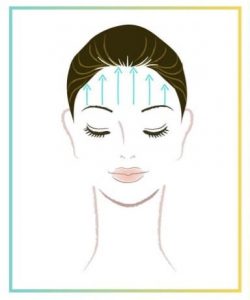
7. Take extra care around the eyes
Next up is the eye area. As always, be extremely delicate in this area, where the skin is thinner and more fragile. Position your fingers on either side of your nose and gently run them upwards toward your temples.
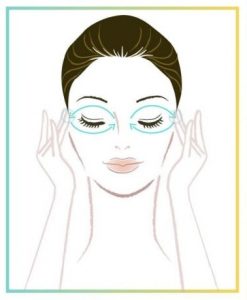
8. Finish with your neck & decolletage
Use light, vertical strokes to massage skin from your chest, up to your neck, and your jawline. This will help to reactivate the lymphatic system and smooth out any fine lines that have collected in this oft-neglected area.
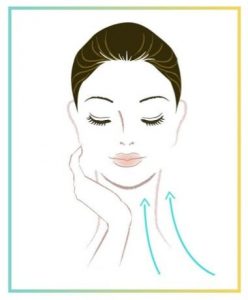
The secret to long-term results is to practice facial massage regularly. Beauty experts recommend adding a facial massage to your skincare routine two to three times per week. This can be beneficial in boosting circulation, softening tension, and – over time – lifting and toning your complexion. Whether you choose your morning or nighttime routine is up to you.
Also, there are several techniques you can use. Here are some methods to do face massage:
- Use a circular motion to rub your fingers into your temples.
- Use your palms and fingertips to massage the sides of your face, starting at your chin and moving up toward your forehead. Then slide your hands back down.
- Press and glide your ring fingers into your brow bone. Move from the inner to the outer corner. Then do the same movement underneath your eyes.
- Using your thumb and first finger, start at the outer corners of your eyebrows. Gently pinch your eyebrows as you move to the inner corner.
- Use your index and middle fingers to press under your cheekbones. Start at the center of your face and move toward your temples.
Also, see a doctor or massage therapist for a facial massage or if you’d like to address specific medical concerns, including acne, TMJ, or scar reduction. A professional will have the skill and expertise to tailor the facial massage to your specific needs.
To conclude, facial massages are a wonderful way to give yourself some healing and rejuvenating TLC while treating specific concerns. Enjoy the process of discovery as you learn to do facial massage on your own or have regular professional treatments.
